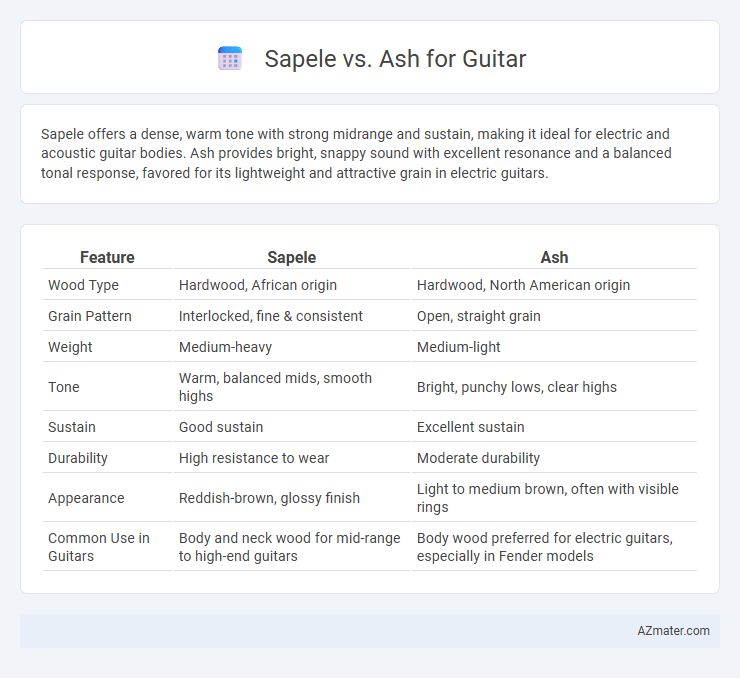Sapele offers a dense, warm tone with strong midrange and sustain, making it ideal for electric and acoustic guitar bodies. Ash provides bright, snappy sound with excellent resonance and a balanced tonal response, favored for its lightweight and attractive grain in electric guitars.
Table of Comparison
| Feature | Sapele | Ash |
|---|---|---|
| Wood Type | Hardwood, African origin | Hardwood, North American origin |
| Grain Pattern | Interlocked, fine & consistent | Open, straight grain |
| Weight | Medium-heavy | Medium-light |
| Tone | Warm, balanced mids, smooth highs | Bright, punchy lows, clear highs |
| Sustain | Good sustain | Excellent sustain |
| Durability | High resistance to wear | Moderate durability |
| Appearance | Reddish-brown, glossy finish | Light to medium brown, often with visible rings |
| Common Use in Guitars | Body and neck wood for mid-range to high-end guitars | Body wood preferred for electric guitars, especially in Fender models |
Introduction to Sapele and Ash in Guitar Building
Sapele is a dense, durable hardwood known for its warm, balanced tone and strong midrange presence, making it a popular choice for guitar bodies seeking warmth and sustain. Ash, particularly swamp ash, is favored for its lightweight properties and bright, snappy sound with pronounced high-end clarity, offering excellent resonance and sustain. Both woods influence the guitar's tonal characteristics and aesthetics, with Sapele producing a richer, fuller sound while Ash delivers a more articulate and lively tone.
Botanical Origins and Characteristics
Sapele, derived from the Entandrophragma cylindricum tree native to West Africa, exhibits a reddish-brown hue with interlocking grain offering rich tonal warmth and strong midrange presence ideal for guitar bodies and necks. Ash, primarily sourced from the Fraxinus genus in North America, features a lighter color with a pronounced, straight grain pattern that contributes to bright, snappy tones favored in electric guitars. Both woods' botanical origins influence their density and resonance, with Sapele's denser structure providing sustain and Ash's lighter grain supporting dynamic response.
Weight and Density Comparison
Sapele wood typically weighs around 640 kg/m3, making it denser and heavier than ash, which averages about 600 kg/m3. This higher density in Sapele provides a more solid, resonant tone with sustained vibrations, while the lighter ash offers a brighter sound with more pronounced attack due to its lower weight. When choosing between Sapele and ash for guitars, the substantial difference in weight and density directly influences playability and tonal characteristics.
Tonal Qualities: Sapele vs Ash
Sapele offers warm, rich tones with pronounced midrange and balanced bass, lending a smooth and rounded sound ideal for blues and jazz styles. Ash provides bright, snappy tones with strong attack, clear treble, and well-defined lows, making it a favorite for rock and aggressive playing. The tonal qualities of Sapele emphasize warmth and sustain, while Ash delivers clarity and dynamic response.
Workability and Crafting Differences
Sapele wood offers excellent workability due to its fine grain and consistent texture, allowing smoother cuts and easier shaping compared to Ash, which has a coarser grain that can be more prone to tear-out during crafting. Ash tends to be lighter and more porous, requiring careful sanding and finishing techniques to achieve a smooth surface, whereas Sapele's natural density contributes to a durable and polished feel with less effort. Crafting guitars from Sapele often benefits from its natural resistance to splitting and warping, making it preferred for intricate designs, while Ash's openness affects sound resonance, influencing luthiers' choices based on tonal goals.
Visual Aesthetics and Grain Patterns
Sapele wood features a rich reddish-brown color with a shimmering, interlocking grain pattern that creates a striking ribbon-like effect, offering a warm and exotic visual appeal for guitars. Ash, primarily known for its pale, creamy tonewood, showcases prominent, open grain patterns with bold, contrasting lines that provide a classic, vintage look often favored in electric guitars. The choice between Sapele and Ash depends on the desired guitar aesthetics, with Sapele delivering smooth, elegant ribbons and Ash presenting more pronounced, rustic grain texture.
Durability and Longevity
Sapele wood offers excellent durability due to its dense, hard grain, making it highly resistant to wear and environmental changes, which ensures longevity for guitar bodies and necks. Ash, particularly swamp ash, is lighter and less dense but still provides good durability with a strong, flexible grain that can withstand impacts and maintain structural integrity over time. Both woods contribute to the guitar's lifespan, but Sapele's higher density generally results in longer-lasting stability and resistance to dents and scratches.
Popular Guitar Models Featuring Sapele or Ash
The Gibson Les Paul Studio and PRS SE models are popular guitars featuring Sapele, valued for its warm tonal qualities and midrange emphasis. Fender Stratocaster and Telecaster models often use Ash, renowned for its bright, snappy sound and excellent sustain, making it a favorite among rock and blues players. Both woods contribute distinct tonal characteristics that influence the playability and sound profile of these iconic guitars.
Price and Availability
Sapele offers a more affordable price point compared to Ash, making it a popular choice for budget-conscious guitarists. While Ash is widely available, especially in North America, Sapele's availability can vary but is generally easier to source in tropical regions. Both woods provide solid tonal qualities, but price and regional availability often influence the final decision.
Choosing Between Sapele and Ash: Which is Best for You?
Sapele offers a warm, balanced tone with strong midrange presence, ideal for players seeking a versatile sound with smooth sustain. Ash features bright, snappy highs and pronounced lows, making it perfect for those who prefer a dynamic, punchy response with clear note definition. Consider your playing style and tonal preferences when choosing between Sapele's rich mellowness and Ash's vibrant attack to find the best wood for your guitar.

Infographic: Sapele vs Ash for Guitar
 azmater.com
azmater.com